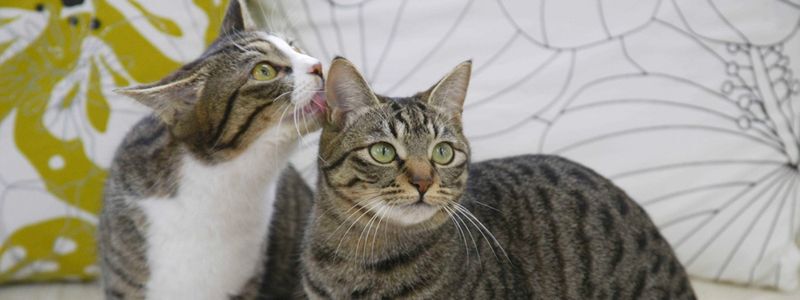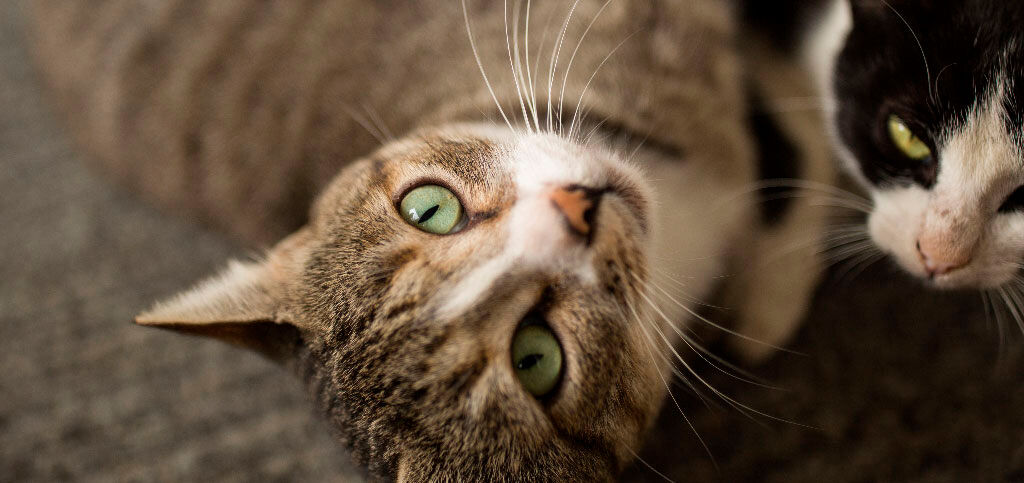Why is it important to know how to introduce a second cat to your household?
Cat ethologist Rosana Álvarez explains:
“Unlike dogs, cats are solitary animals who are very territorial, and they really don’t like change.”
So it’s easy to imagine why the introduction of a new feline companion can sometimes be a tricky process.
However, this doesn’t mean that it isn’t possible to form stable groups of cats in the same household, as long as they don’t have to compete for basic resources such as:
- Food
- The litter tray
- Access to certain areas of the house
- A female in heat
- Etc.
The safest bet for good coexistence is to choose a kitten, or a cat of the opposite sex, but adult cats and cats of the same sex can also form good relationships. It’s simply a question of bearing in mind a few recommendations.
Unlike dogs, cats are solitary animals who are very territorial, and they really don’t like change
Introduction protocol
Experts in cat ethology, the science that studies cat behaviour, have established an introduction protocol that sets out the steps to follow in order to avoid conflict.
The basic aims of this protocol are to:
- Very gradually encourage visual and olfactory contact between the cats.
- Get them used to each other’s presence.
- Increase tolerance towards the new cat.
- Encourage a trusting relationship between the two cats.
The introduction protocols are a series of very practical instructions on how to introduce a second cat to the family. They’re applicable both for when introducing a cat into a home where another is already living, and for introduction to an established group of cats (for example in a shelter).

How to introduce a second cat to your household in 7 steps
If you already have a cat in the family, and you’re thinking of getting another one, the following advice will help to avoid rejection and conflict.
1. All for two, plus one
As we’ve already said, two cats can compete for what they consider to be important resources, such as the litter tray, water and feeding bowls, or access to particular areas of the house.
To avoid conflict related to competition for resources, we recommend that you always have a separate litter tray, water bowl, food bowl and bed or blanket for each cat, plus an extra one of each. In other words, if you have two cats, you’ll need three of everything.
2. Complete separation
The most important rule for introducing a second cat into the house is to keep the new cat apart in a separate room. For the first few days, all contact with the cat already living in the house should be avoided.
The aim is for your cat to be aware that there’s a new individual in the house, but not to perceive him as a competitor or a threat.
Remember that you’ll need to make sure that the new cat has easy access to everything he needs in the room you prepare for him: water, food, a litter tray, a bed or blanket, etc.
Try to choose a peaceful room where people are not constantly coming and going. Your cat needs calm to assimilate all these changes.
You might find that for the first few days your cats hiss and spit at each other from their side of the door. Don’t worry - this is part of the process, and it’s a natural reaction.
3. Olfactory contact
The next step when introducing a second cat to your home is to encourage scent sharing.
Continue to keep the two cats apart. Take a couple of towels, and let the cats rub their faces on them. Then let each cat smell the towel soaked in the other one’s scent, and see how they react.
Bear in mind that cats secrete social pheromones when they rub up against other individuals. Facial marking is reassuring, and serves to identify individuals from the same social group.
4. Visual contact
Once you see that your two cats respond in a positive way to each other’s scent, you can move on to letting them see each other for the first time.
Always keep a glass door, or some kind of netting between them for this first meeting.
Observe their reactions, and separate them again if they hiss or spit at each other.
5. Supervised direct contact
If your cats’ reactions to the previous steps in the protocol have been positive, next you can bring them together under supervision.
Some ethologists recommend offering them food so that they each associate the presence of the other cat with something positive. However, experts such as H.R Askew and S Heath question this recommendation, arguing that in order to gain access to an essential resource such as food, cats may try to supress hostile feelings, but that the social tension generated could lead to an increase in that hostility in other contexts.
6. Unsupervised direct contact
If your cats’ reactions in the previous steps have been positive, you can now leave them alone together unsupervised.
Later on, you can check to see whether or they’ve really hit it off by looking out for what’s known as ‘affiliative behaviour’: grooming each other, or rubbing their faces together.
7. Pheromones
It’s a good idea to use calming pheromones throughout the introduction process. These are available in spray or diffusor formats in any pet shop or veterinary clinic.
If this article has helped you to understand how to introduce a second cat to your household, we recommend that you read this information on how to prepare your home for the arrival of a cat.
Askew, H.R. (2003). Treatment of Cat Behavior Problems -Fear and Aggression Problems.
Treatment of Behavior Problems in Dogs and Cats. 2ª Ed. Blackwell Publishing.
Heath S. (2009). Aggression in cats: D. F. Horwitz and D. S. Mills (Eds) BSAVA Manual of
canine and feline behavioural medicine. 2º ed. BSAVA.
 Copy link
Copy link
 Publish on Facebook
Publish on Facebook
 Publish on Twitter
Publish on Twitter
 Publish on WhatsApp
Publish on WhatsApp
